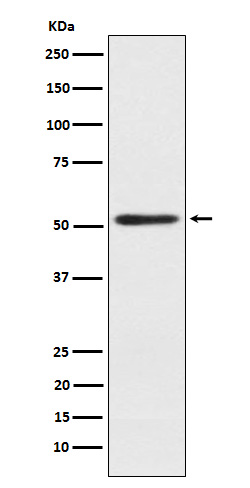Anti-SRP54 Rabbit Monoclonal Antibody
- SPECIFICATION
- CITATIONS
- PROTOCOLS
- BACKGROUND

Application
| WB, IHC, IP, FC |
|---|---|
| Primary Accession | P61011 |
| Host | Rabbit |
| Isotype | IgG |
| Reactivity | Rat, Human, Mouse |
| Clonality | Monoclonal |
| Format | Liquid |
| Description | Anti-SRP54 Rabbit Monoclonal Antibody . Tested in WB, IHC, IP, Flow Cytometry applications. This antibody reacts with Human, Mouse, Rat. |
| Gene ID | 6729 |
|---|---|
| Other Names | Signal recognition particle subunit SRP54, 3.6.5.4, Signal recognition particle 54 kDa protein, SRP54 (HGNC:11301) |
| Calculated MW | 56 kDa |
| Application Details | WB 1:500-1:2000 IHC 1:50-1:200 IP 1:50 FC 1:50 |
| Contents | Rabbit IgG in phosphate buffered saline, pH 7.4, 150mM NaCl, 0.02% sodium azide and 50% glycerol, 0.4-0.5mg/ml BSA. |
| Clone Names | Clone: 20S91 |
| Immunogen | A synthesized peptide derived from human SRP54 |
| Purification | Affinity-chromatography |
| Storage | Store at -20°C for one year. For short term storage and frequent use, store at 4°C for up to one month. Avoid repeated freeze-thaw cycles. |
| Name | SRP54 (HGNC:11301) |
|---|---|
| Function | Component of the signal recognition particle (SRP) complex, a ribonucleoprotein complex that mediates the cotranslational targeting of secretory and membrane proteins to the endoplasmic reticulum (ER) (PubMed:34020957). As part of the SRP complex, associates with the SRP receptor (SR) component SRPRA to target secretory proteins to the endoplasmic reticulum membrane (PubMed:34020957). Binds to the signal sequence of presecretory proteins when they emerge from the ribosomes (PubMed:34020957). Displays basal GTPase activity, and stimulates reciprocal GTPase activation of the SR subunit SRPRA (PubMed:28972538, PubMed:34020957). Forms a guanosine 5'-triphosphate (GTP)-dependent complex with the SR subunit SRPRA (PubMed:34020957). SR compaction and GTPase mediated rearrangement of SR drive SRP-mediated cotranslational protein translocation into the ER (PubMed:34020957). Requires the presence of SRP9/SRP14 and/or SRP19 to stably interact with RNA (By similarity). Plays a role in proliferation and differentiation of granulocytic cells, neutrophils migration capacity and exocrine pancreas development (PubMed:28972538, PubMed:29914977). |
| Cellular Location | Nucleus speckle. Cytoplasm Endoplasmic reticulum |

Thousands of laboratories across the world have published research that depended on the performance of antibodies from Abcepta to advance their research. Check out links to articles that cite our products in major peer-reviewed journals, organized by research category.
info@abcepta.com, and receive a free "I Love Antibodies" mug.
Provided below are standard protocols that you may find useful for product applications.
If you have used an Abcepta product and would like to share how it has performed, please click on the "Submit Review" button and provide the requested information. Our staff will examine and post your review and contact you if needed.
If you have any additional inquiries please email technical services at tech@abcepta.com.













 Foundational characteristics of cancer include proliferation, angiogenesis, migration, evasion of apoptosis, and cellular immortality. Find key markers for these cellular processes and antibodies to detect them.
Foundational characteristics of cancer include proliferation, angiogenesis, migration, evasion of apoptosis, and cellular immortality. Find key markers for these cellular processes and antibodies to detect them. The SUMOplot™ Analysis Program predicts and scores sumoylation sites in your protein. SUMOylation is a post-translational modification involved in various cellular processes, such as nuclear-cytosolic transport, transcriptional regulation, apoptosis, protein stability, response to stress, and progression through the cell cycle.
The SUMOplot™ Analysis Program predicts and scores sumoylation sites in your protein. SUMOylation is a post-translational modification involved in various cellular processes, such as nuclear-cytosolic transport, transcriptional regulation, apoptosis, protein stability, response to stress, and progression through the cell cycle. The Autophagy Receptor Motif Plotter predicts and scores autophagy receptor binding sites in your protein. Identifying proteins connected to this pathway is critical to understanding the role of autophagy in physiological as well as pathological processes such as development, differentiation, neurodegenerative diseases, stress, infection, and cancer.
The Autophagy Receptor Motif Plotter predicts and scores autophagy receptor binding sites in your protein. Identifying proteins connected to this pathway is critical to understanding the role of autophagy in physiological as well as pathological processes such as development, differentiation, neurodegenerative diseases, stress, infection, and cancer.


